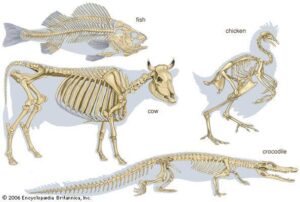Back to: ZOOLOGY 300 Level
Welcome To Class!
Hi there, superstar learner! I’m really glad to have you here today. Get ready for an exciting journey as we look at how the skull and vertebral column differ across various vertebrate animals. From the fish swimming in our rivers to the birds soaring in the sky, these bone structures tell us so much about each animal’s way of life.
Skull And Vertebral Column Comparison Across Vertebrates
What Are the Skull and Vertebral Column?
Before we begin the comparisons, let’s understand what these two parts are:
- The skull is the bony structure that protects the brain and supports the face.
- The vertebral column, also called the backbone or spine, is a series of bones (vertebrae) stacked one on top of another. It supports the body and protects the spinal cord.

Both of these structures are found in all vertebrates, the group of animals with backbones.
Skull Comparison Across Vertebrates
- Fish: The skull of a fish is made up of many small bones. It is not very solid because fish live in water, which helps support their bodies. The jaws are often strong and adapted for catching prey or filtering food.
- Amphibians: Amphibian skulls, like those of frogs, are lightweight with fewer bones than fish. This helps them move more easily on land. Their skulls are also flatter to allow for jumping and movement.
- Reptiles: Reptile skulls are stronger and more solid than amphibians. They have stronger jaws and sharp teeth for hunting. Many reptiles, like snakes, have flexible skulls that allow them to swallow prey much larger than their heads!
- Birds: Birds have lightweight skulls with large eye sockets for sharp vision. Their beaks are made of keratin (like fingernails) and adapted for different feeding styles—like cracking seeds or fishing.
- Mammals: Mammalian skulls are solid and protect large brains. Their teeth are specialised (incisors, canines, molars) based on their diets—herbivores chew plants, while carnivores rip meat.
Vertebral Column Comparison Across Vertebrates
- Fish: Fish have flexible vertebral columns that help with swimming. Their spine moves side-to-side to push them through water.
- Amphibians: Amphibians have fewer vertebrae than fish. Their backbone supports both swimming and simple movement on land.
- Reptiles: Reptiles, especially snakes, have many vertebrae—sometimes hundreds! This gives them their unique slithering movement. Other reptiles like lizards and crocodiles have strong vertebral columns for crawling and tail movement.
- Birds: Birds have a rigid vertebral column to support flight. Their necks are very flexible to allow them to reach different angles with their beaks, while their backbones stay stiff for stability in flight.
- Mammals: Mammals have backbones that support walking, running, climbing, and even swimming. Their spine is divided into regions—cervical (neck), thoracic (chest), lumbar (lower back), sacral (pelvis), and caudal (tail)—to allow flexibility and strength.

Why These Differences Matter
Each animal’s skull and spine are shaped by its lifestyle:
- Fish need flexibility for swimming.
- Birds need light bones for flight.
- Mammals need sturdy support for complex movement.
- Reptiles need a strong spine for crawling and climbing.
This is a beautiful example of evolutionary adaptation—how animals’ bodies are shaped to suit their environment and way of life.
Summary
- The skull protects the brain and helps with feeding. Its shape and strength vary depending on the animal’s needs.
- The vertebral column supports movement and protects the spinal cord. It differs across vertebrates based on how they move—whether they swim, walk, fly, or crawl.
- From fish to mammals, skull and spine structures reveal a lot about how each vertebrate lives, moves, and survives.
Evaluation
- What is the main function of the vertebral column in vertebrates?
- How does a bird’s skull help it fly and feed effectively?
- Why do snakes have so many vertebrae?
- What makes mammalian skulls different from those of fish?
- Give one reason why skulls are lighter in birds than in mammals.
You did amazingly well, my friend! By learning how the skull and spine change across different animals, you’re not just understanding bones—you’re uncovering the story of life, survival, and adaptation! Keep going strong, and remember that Afrilearn is always here to help you become the best version of yourself. See you in the next lesson!
